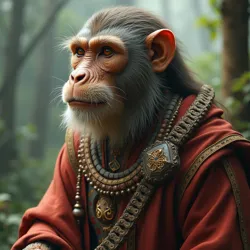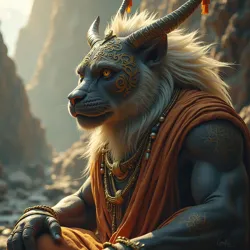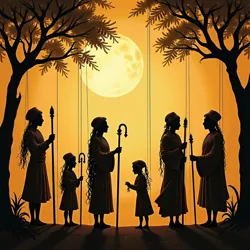Scions of the Simian Sovereigns

Diverse cultures across Marajapatra archipelago united by shared heritage from Simian Sovereigns.
Sovereign-Born
archipelago of Marajapatra
trace origins to Simian Sovereigns
ancestral figures, not deities
shape society, ethics, and arts
The Scions of the Simian Sovereigns, or often simply referred to as the Sovereign-Born, are a diverse array of cultures, societies, and lineages across the archipelago of Marajapatra. United by a shared, though often contested, heritage, they trace their origins back to a complex tapestry of myth and legend centered around figures known as the Simian Sovereigns. These legendary beings, often depicted as possessing extraordinary intellect, agility, and a profound connection to the natural world, are not considered deities in the traditional sense but rather ancestral figures of immense power and cultural significance.
The concept of the Sovereign-Born is not monolithic. It encompasses a spectrum of interpretations, ranging from literal descent from these mythical figures to a more symbolic connection based on shared cultural values and practices attributed to the Sovereigns. In some societies, lineage is meticulously traced, with elaborate genealogies claiming direct descent from specific Sovereigns. In others, the connection is more fluid, defined by adherence to certain ethical codes, artistic traditions, or spiritual practices believed to have originated with the Sovereigns. This diversity is further complicated by geographical separation and historical divergence, leading to a rich mosaic of Sovereign-Born cultures, each with its own unique interpretations and expressions of this shared heritage.
Origins and Mythological Tapestry
The foundational myths surrounding the Simian Sovereigns are deeply embedded in the oral traditions and artistic expressions of Marajapatra. These narratives, passed down through generations of storytellers, artisans, and ritual practitioners, depict a primordial age when the archipelago was inhabited by a pantheon of powerful beings, among whom the Simian Sovereigns held a prominent, though often enigmatic, place. Unlike creation deities or cosmic forces, the Sovereigns are generally portrayed as terrestrial figures, deeply involved in the shaping of the land, the establishment of social orders, and the imparting of crucial knowledge to early human populations.
 The Primal Progenitor depicted as the eldest and most powerful of the Simian Sovereigns in Marajapatran mythology.
The Primal Progenitor depicted as the eldest and most powerful of the Simian Sovereigns in Marajapatran mythology.Central to these myths is the figure of the Primal Progenitor, often depicted as the eldest and most powerful of the Sovereigns. Narratives vary across different regions and cultures, but the Primal Progenitor is consistently associated with acts of creation, the taming of wild landscapes, and the establishment of the first settlements. Some accounts describe the Primal Progenitor as emerging from a sacred mountain peak, imbued with the essence of the earth and sky. Others portray them as arriving from across the vast ocean, bringing with them seeds of civilization and the wisdom of distant lands. Regardless of the specific origin story, the Primal Progenitor is invariably presented as a figure of immense authority and wisdom, setting the precedent for subsequent generations of Sovereigns and their supposed descendants.
Following the Primal Progenitor, the mythology branches into a complex genealogy of lesser Sovereigns, each associated with specific domains of influence. These domains range from natural phenomena like weather patterns and agricultural cycles to more abstract concepts such as craftsmanship, healing, and social justice. For instance, the Whispering Weaver is often invoked in narratives related to textile arts and intricate craftsmanship, believed to have taught the first humans the art of weaving and the secrets of dyes derived from natural pigments. Similarly, the Sure-Footed Shepherd is associated with animal husbandry and the cultivation of fertile lands, credited with introducing domesticated animals and agricultural techniques that transformed early Marajapatran societies.
These Sovereign figures are not depicted as flawless paragons. Myths often recount tales of their internal conflicts, rivalries, and even moments of folly. These narratives serve not only as entertainment but also as moral lessons, illustrating the complexities of power, the importance of balance, and the consequences of hubris. One recurring motif is the Trial of Echoing Cliffs, a legendary contest between two Sovereign siblings vying for dominance over a specific region. The tale, recounted in numerous variations across the archipelago, explores themes of sibling rivalry, strategic cunning, and the ultimate futility of unchecked ambition. These complex and nuanced portrayals of the Sovereigns distinguish them from simplistic heroic archetypes, imbuing their mythology with a depth and resonance that continues to captivate and inform Sovereign-Born cultures.
The myths are not static; they evolve and adapt over time, reflecting the changing social, political, and environmental landscapes of Marajapatra. New Sovereigns are sometimes incorporated into the pantheon, often representing emerging technologies, social movements, or significant historical events. For example, the figure of the Ironclad Artisan, associated with metalworking and technological innovation, is a relatively recent addition to the Sovereign mythology, gaining prominence alongside the rise of industrialized societies in certain regions of the archipelago. This dynamic nature of the mythology underscores its enduring relevance and its capacity to continuously provide meaning and guidance to Sovereign-Born communities.
Cultural Significance and Societal Impact
The mythology of the Simian Sovereigns permeates virtually every facet of Sovereign-Born cultures, shaping social structures, ethical frameworks, artistic traditions, and spiritual practices. The influence is so profound that it is often impossible to disentangle Sovereign-Born identity from the narratives and values attributed to these legendary ancestors. The concept of the Sovereign-Born serves as a unifying thread across diverse communities, providing a shared sense of history and purpose, even amidst significant cultural and linguistic variations.
 Intricate shadow puppetry art form used to retell episodes from the Sovereign myths in Marajapatra.
Intricate shadow puppetry art form used to retell episodes from the Sovereign myths in Marajapatra.In many Sovereign-Born societies, social hierarchy is intricately linked to perceived lineage from specific Sovereigns. Clans and families often trace their ancestry back to particular figures, claiming hereditary rights and privileges based on this supposed descent. These genealogical claims are not merely symbolic; they often translate into tangible social and political power. Ruling elites frequently legitimize their authority by asserting direct lineage from powerful Sovereigns, using elaborate family trees and historical chronicles to bolster their claims. This system of lineage-based social stratification, while varying in its rigidity and application across different regions, has been a persistent feature of many Sovereign-Born societies for centuries.
Ethical codes and moral philosophies are also deeply rooted in the teachings and examples attributed to the Sovereigns. The Precepts of the Pensive Planner, a collection of ethical guidelines purportedly formulated by a Sovereign renowned for strategic thinking and just governance, are widely studied and emulated in many Sovereign-Born communities. These precepts emphasize principles of fairness, wisdom, foresight, and a deep respect for the delicate balance of the natural world. Justice systems, legal frameworks, and social norms are often explicitly or implicitly influenced by these ethical principles, shaping the moral landscape of Sovereign-Born societies.
Artistic traditions across Marajapatra are replete with motifs, symbols, and narratives derived from Sovereign mythology. Sculptures, paintings, textiles, and performing arts frequently depict Sovereign figures, their legendary exploits, and the symbolic creatures associated with them. The intricate Shadow Puppetry of the Silent Sage, for example, is a highly revered art form in certain regions, using elaborate puppets and dramatic narratives to retell episodes from the Sovereign myths, often incorporating moral lessons and philosophical insights. Music and dance are also integral to Sovereign-Born cultural expression, with many traditional forms incorporating rhythmic patterns and movements believed to emulate the agility and grace of the Sovereigns. These artistic expressions serve not only as aesthetic enjoyment but also as vital vehicles for transmitting cultural memory, reinforcing social values, and fostering a sense of collective identity.
Spiritual practices and religious beliefs within Sovereign-Born cultures are deeply intertwined with Sovereign mythology, although the Sovereigns themselves are not typically worshipped as deities in the conventional sense. Instead, they are venerated as ancestral spirits, powerful guides, and exemplars of ideal human qualities. Rituals and ceremonies often involve invocations to specific Sovereigns, seeking their guidance, protection, or blessings. Shrines and sacred sites dedicated to the Sovereigns are common throughout Marajapatra, serving as focal points for communal gatherings, offerings, and spiritual contemplation. The concept of Animistic Accord, a spiritual philosophy prevalent in many Sovereign-Born cultures, emphasizes the interconnectedness of all living things and the importance of maintaining harmony with the natural world, principles often attributed to the wisdom of the Sovereigns and their deep connection to the environment.
Notable Lineages and Houses
The concept of Sovereign-Born lineage has given rise to numerous prominent houses, clans, and dynasties across Marajapatra, each claiming descent from specific Sovereign figures and wielding significant influence in their respective regions. These lineages are not merely historical relics; they continue to play a vital role in contemporary Sovereign-Born societies, shaping political landscapes, economic structures, and cultural dynamics. While the specific details and claims of each lineage vary, they share a common thread of asserting a privileged status based on their purported ancestral connection to the Simian Sovereigns.
 Powerful lineage in western rainforest regions of Marajapatra descended from the Arboreal Architect.
Powerful lineage in western rainforest regions of Marajapatra descended from the Arboreal Architect.The House of the Verdant Canopy, for example, is a powerful lineage dominant in the western rainforest regions of Marajapatra. They trace their ancestry back to the Arboreal Architect, a Sovereign figure associated with forestry, sustainable agriculture, and the intricate art of treehouse construction. The House of the Verdant Canopy has historically controlled vast tracts of forest land, wielding significant economic power through timber trade, medicinal plant harvesting, and ecotourism. Their cultural influence is also considerable, with their traditions emphasizing environmental stewardship, sustainable living, and a deep respect for the biodiversity of the rainforest ecosystem. The current head of the House, known as the Arboreal Warden, holds a hereditary seat on the regional council and is a prominent voice in environmental conservation efforts across Marajapatra.
In contrast, the Guild of the Gilded Gears, a prominent lineage in the eastern coastal cities, claims descent from the Ironclad Artisan. This lineage is associated with technological innovation, craftsmanship in metalwork, and the development of intricate machinery. The Guild of the Gilded Gears has historically dominated maritime trade, shipbuilding, and the burgeoning industrial sectors of the eastern archipelago. Their influence extends into the realm of technological advancement, with members of the Guild often at the forefront of new inventions and engineering projects. The current Master Artificer of the Guild is a highly influential figure in economic and technological policy, advocating for investments in research and development and the adoption of advanced manufacturing techniques.
The Circle of the Cerulean Current, a more esoteric lineage centered in the inland lake regions, traces its ancestry to the Whispering Weaver. This lineage is associated with textile arts, intricate weaving techniques, and a deeper understanding of natural dyes and pigments. While not wielding the same level of overt political or economic power as some other lineages, the Circle of the Cerulean Current holds significant cultural sway, particularly in the realms of fashion, artistic expression, and ritualistic practices. Their textiles are highly prized throughout Marajapatra for their exquisite craftsmanship and symbolic designs, often incorporated into ceremonial garments and sacred artifacts. The Weaver of Whispers, the current leader of the Circle, is a respected authority on traditional arts and crafts, playing a key role in preserving and promoting these cultural heritage traditions.
These are just a few examples of the numerous Sovereign-Born lineages that shape the cultural and societal landscape of Marajapatra. Each lineage, with its unique history, traditions, and spheres of influence, contributes to the complex and multifaceted tapestry of Sovereign-Born identity. The interplay and occasional conflicts between these lineages have been a driving force in Marajapatran history, shaping political alliances, trade networks, and cultural exchanges across the archipelago.
Practices and Traditions
Sovereign-Born cultures are characterized by a rich tapestry of practices and traditions that reflect their shared heritage and their unique adaptations to diverse environments and historical circumstances. These practices range from elaborate ceremonial rituals and artistic expressions to everyday customs and social norms, all imbued with the symbolism and values derived from Sovereign mythology. Many of these traditions have been meticulously preserved and passed down through generations, serving as vital links to the past and reinforcing a sense of collective identity.
Ceremonial rituals play a central role in Sovereign-Born cultural life, marking significant life events, seasonal transitions, and communal celebrations. The Festival of the First Bloom, for example, is a widespread annual celebration marking the beginning of the agricultural cycle, invoking the blessings of the Sure-Footed Shepherd and other Sovereigns associated with fertility and abundance. This festival typically involves elaborate processions, offerings of freshly harvested produce, and communal feasts, often accompanied by traditional music and dance performances. Similarly, the Rite of Ascending Mists, observed in mountainous regions, is a solemn ceremony commemorating ancestral spirits and seeking guidance from the Primal Progenitor, often involving pilgrimages to sacred mountain peaks and the recitation of ancient epics.
Artistic traditions, as previously mentioned, are deeply intertwined with Sovereign mythology. Beyond the Shadow Puppetry of the Silent Sage and the textiles of the Circle of the Cerulean Current, other notable art forms include the intricate Carvings of the Canyon Keepers, sculptures crafted from local stone and wood depicting Sovereign figures and symbolic creatures, often adorning temples and public spaces. The Chant of the Crested Cranes, a form of vocal music prevalent in wetland regions, imitates the calls of cranes and other waterbirds, believed to be sacred messengers of certain Sovereigns. These artistic expressions are not merely decorative; they serve as powerful mediums for storytelling, moral instruction, and the transmission of cultural values.
Everyday customs and social norms are also subtly influenced by Sovereign-Born traditions. Practices related to hospitality, community cooperation, and respect for elders are often explicitly linked to the teachings and examples of the Sovereigns. For instance, the custom of Open Hearth Sharing, prevalent in many rural communities, dictates that households should always offer food and shelter to travelers, reflecting the Sovereign value of generosity and mutual support. Similarly, the emphasis on consensus-based decision-making in village councils and community gatherings is often attributed to the Precepts of the Pensive Planner, valuing wisdom, deliberation, and collective agreement over autocratic rule.
The Order of the Crimson Macaque represents a distinct and formalized tradition within Sovereign-Born culture. This monastic order, found primarily in secluded mountain monasteries, is dedicated to the study and preservation of Sovereign mythology, philosophy, and ritualistic practices. Members of the Order, known as Crimson Ascetics, undergo rigorous training in ancient languages, historical chronicles, and meditative disciplines. They serve as custodians of sacred texts, repositories of traditional knowledge, and spiritual advisors to communities throughout Marajapatra. The Order maintains a strict code of conduct, emphasizing detachment from worldly possessions, devotion to scholarly pursuits, and a commitment to serving the spiritual needs of the Sovereign-Born populace.
Legacy and Enduring Influence
The legacy of the Simian Sovereigns and the traditions of the Sovereign-Born continue to exert a profound and enduring influence on Marajapatran societies. Despite the passage of centuries and the significant transformations that have shaped the archipelago, the core tenets of Sovereign mythology, the values it espouses, and the cultural practices it has inspired remain deeply embedded in the fabric of Sovereign-Born identity. This enduring influence is evident in contemporary art, literature, political discourse, and social movements, demonstrating the ongoing relevance and vitality of this rich cultural heritage.
In contemporary art and literature, Sovereign mythology continues to be a rich source of inspiration. Modern artists reinterpret traditional motifs and narratives, exploring contemporary themes through the lens of ancient legends. Novelists and poets draw upon Sovereign archetypes and moral dilemmas to comment on contemporary social issues, political complexities, and the human condition. The Symphonies of the Sovereign Echoes, a series of modern orchestral compositions, incorporates traditional musical forms and thematic elements from Sovereign mythology, achieving widespread acclaim and demonstrating the enduring appeal of these ancient narratives in modern artistic expressions.
Political discourse in many regions of Marajapatra frequently invokes Sovereign-Born heritage to legitimize political agendas, advocate for social reforms, or mobilize collective action. Politicians often frame their policies and initiatives in terms of upholding Sovereign values, appealing to a shared sense of history and cultural identity. Social movements advocating for environmental protection, social justice, or cultural preservation often draw inspiration from Sovereign mythology, citing ancestral wisdom and ethical principles to support their causes. The concept of Sovereign Stewardship, emphasizing responsible governance and a commitment to the well-being of future generations, has become a prominent theme in contemporary political debates, directly referencing the ethical frameworks attributed to the Sovereigns.
The enduring influence of the Sovereign-Born is also evident in contemporary social movements aimed at preserving cultural heritage and promoting inter-cultural understanding. Efforts to revitalize traditional art forms, languages, and ritual practices are often framed as essential to maintaining Sovereign-Born identity and resisting the homogenizing pressures of globalization. Initiatives promoting dialogue and cooperation between different Sovereign-Born communities, recognizing their shared heritage while respecting their diverse expressions of it, are gaining momentum, fostering a stronger sense of collective identity and solidarity across the archipelago.
In conclusion, the Scions of the Simian Sovereigns represent a vibrant and diverse array of cultures united by a shared heritage rooted in a rich mythology. Their enduring legacy is evident in the art, traditions, social structures, and ethical frameworks that continue to shape Marajapatran societies. The concept of the Sovereign-Born serves as a powerful unifying force, providing a sense of historical continuity, cultural identity, and shared purpose in a rapidly changing world. The ongoing evolution and reinterpretation of Sovereign mythology ensures its continued relevance and its capacity to inspire and guide future generations.